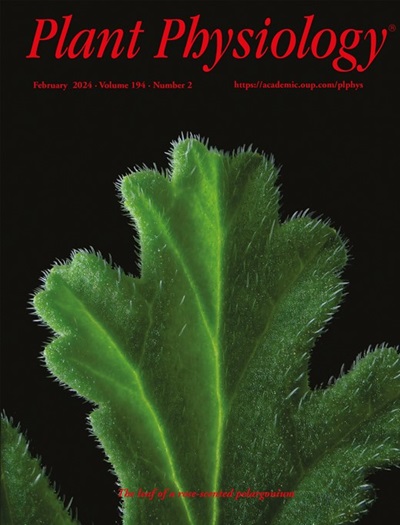真核浮游植物中的类异戊二烯:代谢多样性、生态生理学和生物技术机遇。
IF 6.5
1区 生物学
Q1 PLANT SCIENCES
引用次数: 0
摘要
类异戊二烯是藻类生理和生态所必需的多种代谢物,具有生物技术潜力。尽管最近人们对利用工程微藻生产高价值的类异戊二烯感兴趣,但对其内源性生物合成和调控网络的了解仍然不完整。事实上,主要的焦点仍然是生物技术的应用,而不是生理上的相关性。本文通过全面评估不同微藻类群的类异戊二烯生物合成和调控,以及研究主要代谢途径(叶绿体定位的2- c -甲基- d -红藓糖醇4-磷酸(MEP)和胞质甲基戊酸(MVA)途径)之间的关键异同,弥补了这一空白。强调了这些途径的明显区隔化,特别是与源于初级和次级内共生事件的谱系特异性进化轨迹有关。独特的酶适应和谱系特异性的类胡萝卜素生物合成酶使藻类的类异戊二烯代谢不同于植物、真菌和动物,以反映其生态和生理。此外,我们还探索了类异戊二烯生物合成中多种调控系统的新证据,如转录和转录后调控机制,以及反馈回路和代谢物传感系统。我们讨论了MEP和MVA途径之间复杂的相互作用,特别是关于代谢物串扰、酶的差异定位和物种特异性代谢差异。以特殊代谢物如甾醇硫酸盐和类异戊二烯衍生软骨藻酸为例,我们强调了关于类异戊二烯生态功能尚未解决的问题。最后,我们提出了利用微藻代谢进行可持续萜类生物合成的合成生物学策略,确定了代谢工程的有前途的途径,并将这一综合综述与目前正在进行的类异戊二烯生物技术工作联系起来。本文章由计算机程序翻译,如有差异,请以英文原文为准。
Isoprenoids in eukaryotic phytoplankton: metabolic diversity, eco-physiology and biotechnological opportunities.
Isoprenoids are a diverse group of metabolites essential for algal physiology and ecology, which hold biotechnological potential. Despite recent interest in engineering microalgae for high-value isoprenoid production, understanding of their endogenous biosynthesis and regulatory networks remains fragmented. The major focus, in fact, is still on biotechnological applications rather than physiological relevance. This review bridges this gap by comprehensively evaluating isoprenoid biosynthesis and regulation across diverse microalgal taxa and by examining key differences and similarities between primary metabolic pathways: the chloroplast-localized 2-C-methyl-D-erythritol 4-phosphate (MEP) and cytosolic mevalonate (MVA) pathways. The distinct compartmentalization of these pathways is highlighted, especially in relation to lineage-specific evolutionary trajectories which derive from primary and secondary endosymbiotic events. Unique enzymatic adaptations and lineage-specific carotenoid biosynthesis enzymes make algal isoprenoid metabolism distinct from that of plants, fungi and animals, to reflect their ecology and physiology. Furthermore, we explore emerging evidence on multiple regulatory systems in isoprenoid biosynthesis, such as transcriptional and post-transcriptional regulatory mechanisms, alongside feedback loops and metabolite sensing systems. We discuss the complex interplay between MEP and MVA pathways, especially regarding metabolite crosstalk, differential localization of enzymes, and species-specific metabolic divergence. Using specialized metabolites like sterol sulfates and isoprenoid-derived domoic acid as examples, we highlight unresolved questions regarding isoprenoid ecological functions. Finally, we present synthetic biology strategies harnessing microalgal metabolism for sustainable terpenoid biosynthesis, identifying promising avenues for metabolic engineering and connecting this comprehensive review to the work currently ongoing in isoprenoid biotechnology.
求助全文
通过发布文献求助,成功后即可免费获取论文全文。
去求助
来源期刊

Plant Physiology
生物-植物科学
CiteScore
12.20
自引率
5.40%
发文量
535
审稿时长
2.3 months
期刊介绍:
Plant Physiology® is a distinguished and highly respected journal with a rich history dating back to its establishment in 1926. It stands as a leading international publication in the field of plant biology, covering a comprehensive range of topics from the molecular and structural aspects of plant life to systems biology and ecophysiology. Recognized as the most highly cited journal in plant sciences, Plant Physiology® is a testament to its commitment to excellence and the dissemination of groundbreaking research.
As the official publication of the American Society of Plant Biologists, Plant Physiology® upholds rigorous peer-review standards, ensuring that the scientific community receives the highest quality research. The journal releases 12 issues annually, providing a steady stream of new findings and insights to its readership.
 求助内容:
求助内容: 应助结果提醒方式:
应助结果提醒方式:


